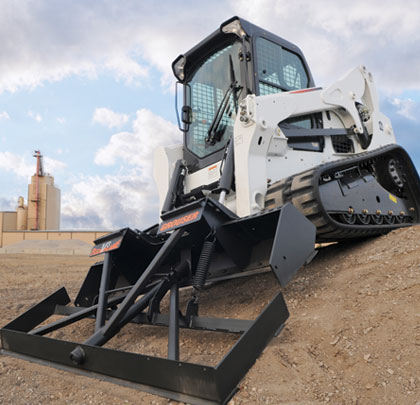Whether performing site preparation, installing irrigation systems, building a deck or patio, contractors, homeowners, landscapers, and farmers understand the importance of shaping the ground.
Land leveling is pivotal in the progression of most construction or rebuilding projects. Thankfully, whatever the situation or ground conditions, grading can be simple, especially with equipment that allows for flexibility. There are a few key features to look for in a land grader, as well as tricks of the trade to keep in mind, such as safety, jobsite terrain, proper operation, and the best tools for the job.
SAFETY FIRST
As with any job, safety is the top priority. No one should run a skid steer with a plane attachment without proper training, both on operation and safety. Further, utilities are everywhere and unfortunately are commonly buried too shallow, 2 inches below the grade on construction sites.
Properly trained operators should make sure the attachment mechanism is locked firmly into any skid loader. It’s of utmost importance to constantly be aware of buildings, cars, or other people on the site. Operators also need to be conscious of hazards on the jobsite that come between the plane and finished grade. Visibility is crucial in ensuring accuracy and care across concrete paths, curbs, and even the grass that ties into the finished grade. An open-view land grader that maximizes visibility of the forward cutting edge can provide the best sight lines and control.
MAKE A PLAN
Once those issues have been addressed, it’s time to devise a plan for leveling the site. Whether it’s a reconstruction or new construction jobsite, soil types and contours all need to be considered. Any large debris, including rocks or weeds, should be removed prior to grading. Deep ruts on jobsites should be carefully evaluated, as well as whether the project requires the addition or subtraction of material.
Soil types vary considerably based on the jobsite, weather, and region. Land planes are known to work with an array of materials—ranging from black dirt to recycled asphalt. While sandy soils are very workable, wet clay commonly gums up and forms clumps on contact, making it a difficult material to plane. In this type of soil, it’s often best to let the clay dry and harden. Once the material is 90 percent dry, clumping should be minimized. At that time, operators can use a grader with a crossbeam, which is designed to break up clods of dirt and clay, to create a smooth, finished surface.
On other jobsites, some moisture can help control dust. Particularly when working with dry, hard-packed grounds, operators should consider spraying water over the area before grading, if possible.
Finally, the operator needs to account for the project parameters, including grade requirements, property lines, and so on. An engineer, a contractor, or the landowner establishes those factors in advance.
A PIVOTAL POINT
Blending areas and leveling between high and low spots can be done easily on flat ground with a skid steer and a rigid plane attachment. However, by definition rigid planes are unyielding and do not adjust, making them difficult to operate on slopes or hills.
For more varied elevations, pivoting land graders like the Grouser V3 Flex Plane are ideal. These attachments pivot to adjust to topographical variations and follow the contours of the ground. This flexibility allows the operator to work the exact angle of the grade and enables the tires of the skid steer to operate on a plane separate from the grading bar.
An operator grading a mound with a rigid plane would need to be sure the wheels of the skid steer are perpendicular to the slope. The operator would be forced to work up and down instead of side to side. By comparison, a pivoting, flexible plane allows the operator to work from different directions on the slope, although working on slopes greater than 2:1 without additional support or bracing should be avoided.
Some blades provide another advantage. Land planes with single-beveled cutting edges are designed for use in only one direction, usually reverse. In contrast, land planes with double-beveled cutting edges work either in forward or reverse. This provides increased flexibility and ease of operation while reducing the number of necessary passes and limiting the amount of compaction to the soil.
Many land levelers don’t accommodate necessary height adjustments, as they’re set at the height of the skid steer’s boom arm. This one-size-fits-all approach doesn’t allot for the type of skid steer or the weight of the operator. A vertical height adjustment is crucial to optimizing the performance of the cutter and ensuring proper operation and pressure.
SMOOTH OPERATOR
Since the pivoting plane operates differently than rigid planes, it’s important to consider how to work with the attachment before jumping into a skid steer and learning on the fly. Instructional videos and owners manuals give tips on proper operation, maintenance and do’s and don’ts.
With just a little practice, operators can transition from a rigid plane to a pivoting unit, smoothly bringing them from ruts to level ground. ■
About The Author:
Steve Ishaug is a design engineer with Grouser Products, and Brett Kallias is the owner/director of operations with Accelerated Green Works, Inc. For more information on Grouser products, visit www.grouser.com.
_________________________________________________________________________
Modern Contractor Solutions, September 2013
Did you enjoy this article?
Subscribe to the FREE Digital Edition of Modern Contractor Solutions magazine.

Just Plane Easy


